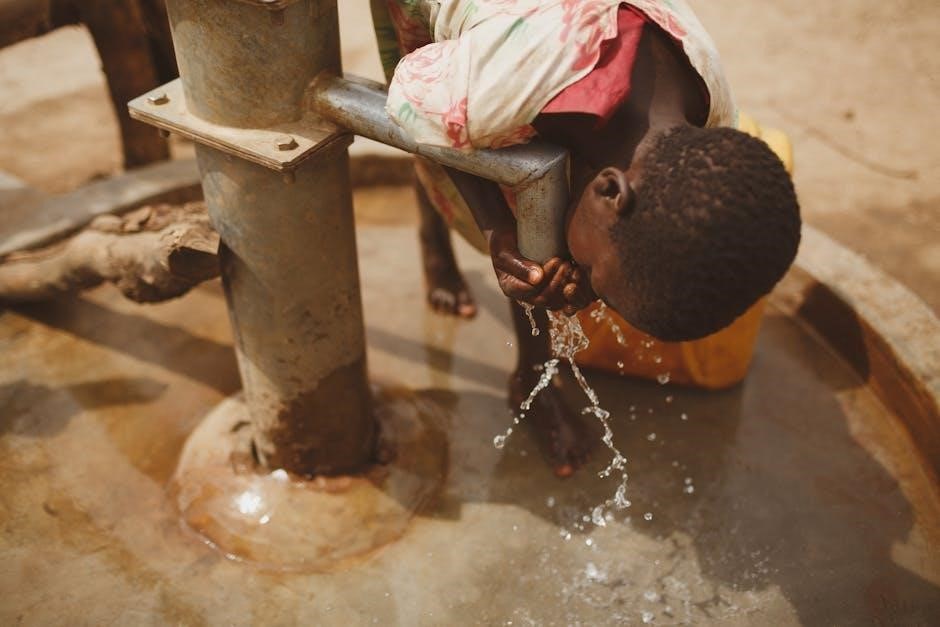survival guides
- Published
- in Guide
Survival guides are comprehensive resources that teach essential wilderness and urban survival techniques‚ ensuring preparedness and self-reliance in challenging environments‚ while fostering mental resilience and tool-crafting skills.

Overview of Survival Skills
Survival skills encompass a wide range of practical abilities essential for staying alive in adverse conditions. These skills include finding food and water‚ building shelter‚ navigating terrain‚ and providing first aid. Adaptability and critical thinking are key‚ as survival often requires creative problem-solving. Techniques vary depending on the environment‚ whether wilderness or urban‚ and may involve crafting tools or using natural resources effectively. Mental resilience plays a crucial role‚ as maintaining calm and focus enhances decision-making. These skills are not only for emergencies but also foster self-reliance and confidence in everyday life‚ ensuring preparedness for unexpected challenges.

Essential Survival Skills
Mastering skills like finding food‚ building shelter‚ navigation‚ and first aid is crucial for survival‚ ensuring safety and sustainability in challenging environments‚ while staying calm and resourceful.
Finding Food and Water in the Wild
Locating a reliable water source‚ such as streams or ponds‚ is critical for survival. Purify water using methods like boiling‚ sand filtration‚ or solar disinfection to avoid contamination. Foraging for edible plants‚ like berries‚ nuts‚ and dandelions‚ can provide sustenance‚ but ensure they are safe to eat. Hunting small game with traps or snares is another option‚ while fishing requires minimal equipment. Always prioritize water conservation and ration food to extend supplies. Signaling for help‚ such as creating smoke or using reflective surfaces‚ can aid in rescue. Staying near water sources increases chances of being found and sustains energy for survival.
- Purify water before consumption.
- Identify edible plants carefully.
- Conserve resources to prolong survival.

Building Shelter
Shelters protect from harsh weather and wildlife. Use natural materials like branches and leaves for lean-tos or debris huts. Stay dry and insulated for better survival.
- Lean-tos: Simple structures using poles and a ridge.
- Debris huts: Domes built with sticks and leaves.
- Stay dry to avoid hypothermia.
Constructing Emergency Shelters

Emergency shelters are crucial for survival‚ providing protection from harsh weather and wildlife. Use natural materials like branches‚ leaves‚ and snow to build lean-tos or debris huts. Start by gathering sturdy poles for the frame‚ then cover with foliage or snow for insulation. Ensure the shelter is waterproof by lining it with plastic or large leaves. Choose a dry‚ elevated spot to avoid flooding. If possible‚ use a tarp or space blanket for added protection. A well-constructed shelter can safeguard against hypothermia‚ rain‚ and wind‚ increasing your chances of survival in the wilderness. Stay visible by placing bright markers near your shelter.
Navigation Techniques
Mastering navigation involves using compasses‚ maps‚ and natural landmarks to determine direction. Techniques include triangulation‚ tracking‚ and celestial navigation‚ ensuring accurate travel in unfamiliar territories effectively.
Using Compass and Natural Landmarks
Navigating with a compass involves aligning the needle with magnetic north and rotating the bezel to set your course. Natural landmarks like the sun‚ stars‚ and topographical features can also guide you. The sun rises in the east and sets in the west‚ while constellations like the North Star indicate direction. Landmarks such as rivers‚ mountains‚ and valleys can help pinpoint locations. By combining compass readings with natural signs‚ you can accurately determine your position and path‚ ensuring effective navigation in wilderness or urban environments. This skill is crucial for survival‚ enabling you to move safely and purposefully toward your destination.

First Aid and Health
First aid is crucial for treating injuries and preventing infections in survival situations. It involves assessing wounds‚ stopping bleeding‚ splinting fractures‚ and administering basic medical care to ensure recovery and stability.
Emergency Medical Care in Wilderness
Emergency medical care in the wilderness requires quick‚ effective actions to stabilize injuries. Prioritize controlling bleeding with direct pressure or tourniquets‚ clean wounds to prevent infection‚ and immobilize fractures or sprains. Monitor vital signs like breathing and pulse to assess severity. Administer basic first aid‚ such as applying dressings or splints‚ and use pain relief if available. Carry a compact first-aid kit with essentials like bandages‚ antiseptics‚ and medical tape. Knowledge of basic techniques‚ like CPR and wound management‚ is critical. Stay calm and act decisively to prevent minor injuries from escalating into life-threatening conditions in remote areas with limited medical resources.

Mental Resilience
Cultivate mental resilience through positive thinking‚ emotional discipline‚ and focus. This enables survival by maintaining clarity and calmness under stress‚ ensuring rational decision-making in life-threatening situations.
Staying Calm and Focused
Staying calm and focused is crucial for survival. Techniques like deep breathing and positive visualization help maintain emotional balance. Prioritize tasks‚ break challenges into manageable steps‚ and avoid panic. A clear mind enhances decision-making and resource management‚ increasing chances of resolving crises effectively. Regular mental exercises and mindfulness practices can improve your ability to remain composed under pressure. Remember‚ focus drives efficiency‚ while calmness ensures clarity in critical situations. Mastering these skills is essential for overcoming adversity and thriving in survival scenarios.

Tools and Weapons

Tools and weapons are essential for survival‚ enabling tasks like cutting‚ hunting‚ and shelter-building. Crafting and using them effectively enhances safety and efficiency in wilderness scenarios.
Crafting and Using Basic Tools
Crafting basic tools is vital for survival‚ enabling tasks like cutting‚ hunting‚ and shelter-building. Essential tools include knives‚ rope‚ and hardware for constructing shelters. These tools help in securing food‚ building protection‚ and navigating challenging environments. Materials such as wood‚ bone‚ and stone can be shaped into functional items. Mastery of tool crafting enhances safety and efficiency‚ ensuring better chances of survival in the wild.

Urban Survival Tips
Urban survival requires situational awareness‚ securing supplies‚ and avoiding risks. Navigating dangerous environments efficiently ensures safety and resourcefulness in city challenges.
Navigating Dangerous City Environments
Navigating dangerous city environments requires a mix of situational awareness‚ resourcefulness‚ and caution. Stay alert to potential risks‚ avoid poorly lit or isolated areas‚ and keep valuables secure. Utilize technology like maps or safety apps to plan routes and avoid hazards. Building a mental map of safe zones and emergency services is crucial. Carry essential items like a first-aid kit and a portable charger. Trust instincts and avoid engaging with suspicious individuals. Stay informed about local conditions and protests. Learning self-defense techniques can also enhance safety. By combining preparation and vigilance‚ urban survival becomes more manageable and less intimidating.
Survival guides emphasize preparedness and resilience‚ equipping individuals with the skills to navigate emergencies. Mastery of these techniques fosters confidence in overcoming challenges.
Final Thoughts on Survival Preparedness
Survival preparedness is a vital skill that empowers individuals to face unexpected challenges with confidence. By mastering essential techniques like finding food‚ building shelter‚ and navigating‚ one can ensure safety in wilderness or urban environments. Mental resilience plays a crucial role‚ as staying calm and focused often determines survival outcomes. Equipping oneself with basic tools and knowledge significantly enhances readiness. Regular practice and staying informed about new strategies are key to staying prepared. Ultimately‚ survival preparedness is not just about skills—it’s a mindset that fosters self-reliance and the ability to thrive in adversity.
